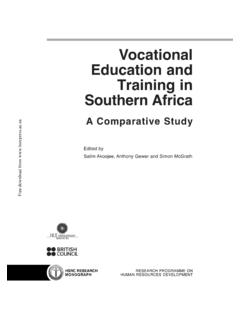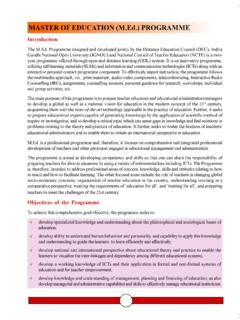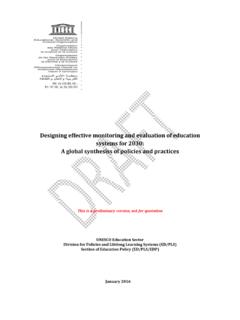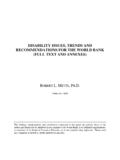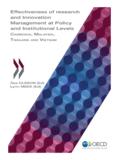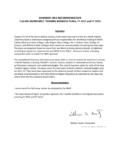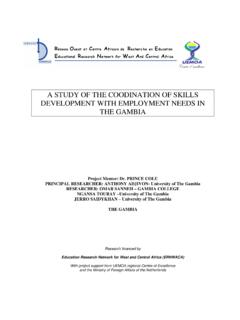Transcription of EDUCATION POLICY OUTLOOK JAPAN - OECD.org
1 EDUCATION POLICY OUTLOOK . JAPAN . EDUCATION POLICY OUTLOOK : JAPAN OECD 2015 1. November 2015. EDUCATION POLICY OUTLOOK . This POLICY profile on EDUCATION in JAPAN is part of the EDUCATION POLICY OUTLOOK series, which presents comparative analysis of EDUCATION policies and reforms across OECD countries. Building on the OECD's substantial comparative and sectorial POLICY knowledge base, the series offers a comparative OUTLOOK on EDUCATION POLICY by providing analysis of individual countries' educational context, challenges and policies ( EDUCATION POLICY profiles), analysis of international trends, and insight into policies and reforms on selected topics. In addition to country-specific profiles, the series also includes a recurring publication. The first volume, EDUCATION POLICY OUTLOOK 2015: Making Reforms Happen, was released in January, 2015. Designed for POLICY makers, analysts and practitioners who seek information and analysis of EDUCATION POLICY taking into account the importance of national context, the country POLICY profiles offer constructive analysis of EDUCATION POLICY in a comparative format.
2 Each profile reviews the current context and situation of a country's EDUCATION system and examines its challenges and POLICY responses, according to six POLICY levers that support improvement: Students: How to raise outcomes for all in terms of 1) equity and quality and 2) preparing students for the future Institutions: How to raise quality through 3) school improvement and 4) evaluation and assessment System: How the system is organised to deliver EDUCATION POLICY in terms of 5) governance and 6) funding. Some country POLICY profiles contain spotlight boxes on selected POLICY issues. They are meant to draw attention to specific policies that are promising or showing positive results and may be relevant for other countries. Special thanks to the Government of JAPAN (through its Ministry of EDUCATION , Culture, Sports, Science and Technology) for its active input during consultations and constructive feedback on this report.
3 Authors: This country POLICY profile was prepared by Tadakazu Miki (main drafter), Beatriz Pont, Diana Toledo Figueroa, Judith Peterka and Sylvain Fraccola (statistics and design), from the EDUCATION POLICY OUTLOOK team, which is part of the POLICY Advice and Implementation Division, led by Richard Yelland. Hiroko Ikesako also contributed during the revision process of this country profile. Editorial support was provided by Sophie Limoges and Susan Copeland. This profile builds on the knowledge and expertise of many project teams across the OECD's Directorate for EDUCATION and Skills, to whom we are grateful. Sources: This country profile draws on OECD indicators from the Programme for International Student Assessment (PISA), the Survey of Adult Skills of the Programme for International Assessment of Adult Competencies (PIAAC), the Teaching and Learning International Survey (TALIS) and the annual publication EDUCATION at a Glance, and refers to country and thematic studies such as OECD work on early childhood EDUCATION and care, teachers, school leadership, evaluation and assessment for improving school outcomes, equity and quality in EDUCATION , governing complex EDUCATION systems, vocational EDUCATION and training, and tertiary EDUCATION .
4 Much of this information and documentation can be accessed through the OECD EDUCATION GPS at Most of the figures quoted in the different sections refer to Annex B, which presents a table of the main indicators for the different sources used throughout the country profile. Hyperlinks to the reference publications are included throughout the text for ease of reading, and also in the References and further reading section, which lists both OECD and non-OECD sources. More information is available from the OECD Directorate for EDUCATION and Skills ( ). and its web pages on EDUCATION POLICY OUTLOOK ( ). EDUCATION POLICY OUTLOOK : JAPAN OECD 2015 2. TABLE OF CONTENTS. Highlights .. 4. Equity and quality High performance and equitable access, some challenges at the school level .. 6. Preparing students for the future A highly-educated workforce .. 8. School improvement Supporting teachers .. 10. Evaluation and assessment to improve EDUCATION and student outcomes Evaluation at different levels.
5 12. Governance A comprehensive and diversified system .. 14. Funding Fewer students per teacher in disadvantaged schools .. 16. Annex A: Structure of JAPAN 's EDUCATION system .. 18. Annex B: Statistics .. 19. References and further reading .. 22. Figures Figure 1. Performance of adults in literacy, 15-year-olds in mathematics and impact of ESCS .. 5. Figure 2. Tertiary attainment of 25-34 year-olds .. 5. Figure 3. Percentage of low and top performers .. 7. Figure 4. Students in EDUCATION and not in EDUCATION , by educational attainment and work status .. 9. Figure 5. School principals' and students' views on learning environment .. 11. Figure 6. Student assessment by purpose .. 13. Figure 7. Decisions in public lower secondary schools, by level of government .. 15. Figure 8. Expenditure on educational institutions as a percentage of GDP .. 17. Spotlights Spotlight 1. Incremental introduction of free tuition in early childhood EDUCATION .
6 7. Spotlight 2. Developing global human resources .. 9. EDUCATION POLICY OUTLOOK : JAPAN OECD 2015 3. HIGHLIGHTS. JAPAN 's educational context Students: JAPAN is among the top PISA 2012 performers in mathematics, science and reading, with improvements in reading and science across PISA cycles and unchanged performance in mathematics. The impact of socio-economic background on student performance is below the average across OECD countries. Pre- primary EDUCATION usually starts at age 3, and the number of 3-4 year-olds enrolled is above the OECD average, although enrolment is mainly in private institutions. In compulsory EDUCATION (from age 6 to age 15) school choice is limited, with tracking starting at age 15 and no grade repetition. JAPAN has an above-average attainment rate in upper secondary EDUCATION , although fewer students than the OECD average are enrolled in upper secondary vocational EDUCATION and training (VET).
7 While POLICY has aimed to reduce competitive pressures, particularly for entrance to university, privately-run juku (private after-hours tutoring schools) remain an important feature of the EDUCATION system. Unemployment remains below the OECD average. According to the Survey of Adult Skills, adults (16-65 year-olds) have high literacy and numeracy skills compared to other countries, and literacy skills are even higher among 16-24 year-olds. Institutions: In 2011, JAPAN increased the total number of study hours in primary and lower secondary EDUCATION , in order to reduce dependence on private EDUCATION resources. Japanese schools have the highest level of autonomy among OECD countries regarding curriculum and student assessment policies. Access to the teaching profession in JAPAN is well-regulated. Lower secondary teachers are generally required to follow a pre- service teacher training programme of four years at a university, including a mandatory teaching practicum.
8 They must then pass a competitive examination to become teachers and, later, complete an induction process. Class size is above the OECD average in primary and lower secondary schools, and Japanese lower secondary teachers have one of the longest working hours among countries participating in TALIS (including teaching and other work-related tasks). A lower proportion of teachers in JAPAN than the TALIS average consider that the teaching profession is valued in society and would choose to work as teachers if they could decide again. School evaluation is conducted by each school, according to criteria set out in a national framework. System: Central and local authorities are responsible for decision-making in JAPAN 's EDUCATION system. The Ministry of EDUCATION , Culture, Sports, and Science and Technology (MEXT) is the main body in charge of EDUCATION . Most schooling decisions in lower secondary EDUCATION are taken by regional and local governments and schools.
9 The share of GDP devoted to educational institutions (all EDUCATION levels combined) is below the OECD average, with a higher share of private funding than the OECD average. With more students entering higher EDUCATION in JAPAN , the country is experiencing an increasing demand for scholarship loans. Key POLICY issues Despite recent POLICY measures, competitive pressures remain strong in JAPAN . EDUCATION outcomes are good by international standards, but JAPAN faces challenges facilitating the transition from school to work in a context of globalisation and a decreasing working-age population. Measures to increase participation of women in the labour market (including increasing childcare and after-school care) should improve the utilisation of high quality human capital. Other challenges include ensuring that the increase in study hours for students at schools does not weaken the overall quality of the teaching provided.
10 To deliver quality teaching, teachers need opportunities to improve professionally. Engaging local communities in children's EDUCATION is also a high priority. JAPAN aims to maintain equal opportunities and ensure standards of quality EDUCATION for all beyond compulsory EDUCATION , as well as to secure funds to achieve the targets established by the government. Recent POLICY responses The Second Basic Plan for the Promotion of EDUCATION ( ) (2013-17), adopted upon Cabinet decision, is a comprehensive plan for EDUCATION formulated by the national government based on the Basic Act on EDUCATION ( ). The Courses of Study, which serves as fundamental standards for the school curriculum from primary to upper secondary levels, was revised in 2008/09. Central to the revised guidelines is the idea of nurturing a zest for life in students. The new standards enrich the content of EDUCATION and increase the number of classes, with an emphasis on the balance between acquiring basic and fundamental knowledge and skills and fostering the ability to think, make decisions, and express oneself.










